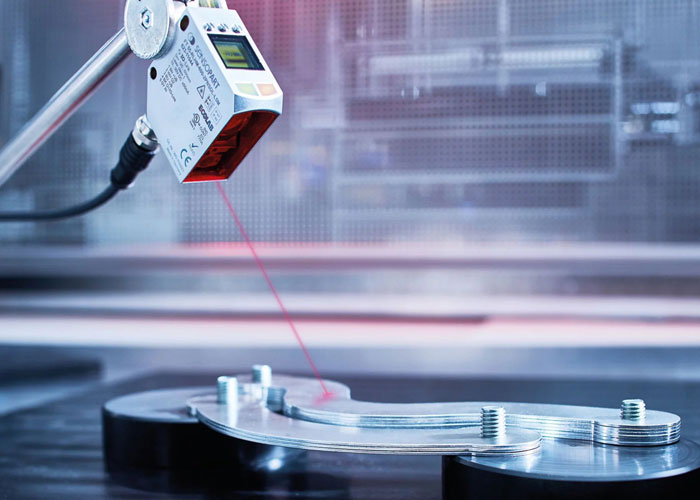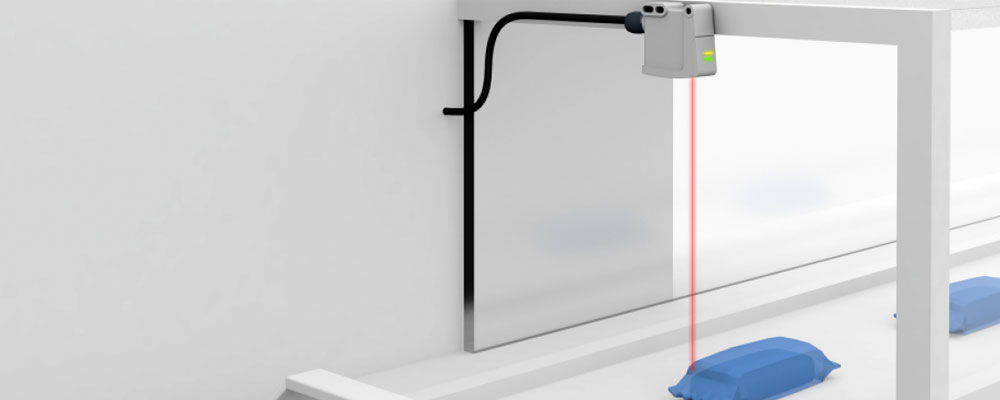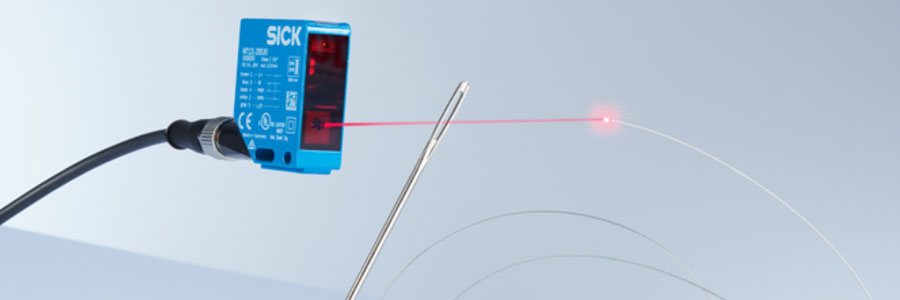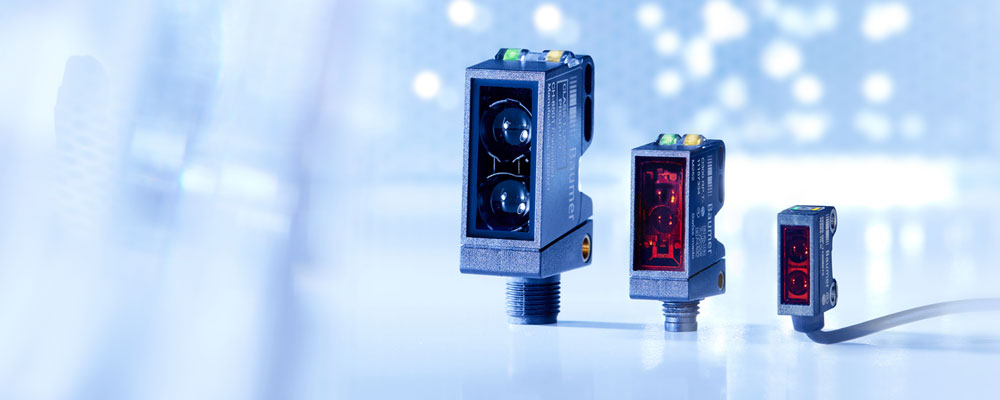Through Beam Photoelectric Sensors
Through-beam photoelectric sensors, also called transmitted beam sensors, use an emitter and a receiver positioned opposite each other to detect objects. The emitter sends out a beam of light, which is either visible or infrared, and the receiver detects this light.
Due to their high accuracy and reliability, through-beam Photoelectric sensors are used in a wide range of industries, including manufacturing, packaging, logistics, and automation systems. Common applications include object detection, counting, and positioning tasks, as well as safety and security systems.
What is a Through Beam Photoelectric Sensor?
A Through Beam Photoelectric Sensor has two parts: an emitter that generates a light beam and a receiver that detects its presence or absence. They are usually installed opposite to each other.
The emitter constantly transmits light to the receiver, and when an object passes between them, it interrupts the light beam. When the sensor detects an interruption, it sends a signal to initiate a response. Through-beam sensors can cover long distances, making them suitable for specific applications.
Through Beam Sensor Working Principle
The working principle of a Through Beam Photoelectric Sensor is based on the interruption of a light beam between an emitter and a receiver.
How it works:
Emission of Light: The emitter sends out a beam of light (which can be visible or infrared). The emitter and receiver are placed opposite each other, with the light beam directly connecting them.
Detection of Light: The receiver continuously detects the presence of this light beam.
Interruption and Signal Generation: When an object passes between the emitter and receiver, it blocks or interrupts the light beam. The receiver, noting the absence of light, generates an output signal.
Triggering a Response: This output signal can be used to trigger a specific response, such as stopping a conveyor belt or turning on a machine. The exact response depends on the system in which the sensor is integrated.
Through Beam, Sensors offer the longest sensing range and highest excess gain (ability to detect objects through contaminants like dust or moisture). They are ideal for applications where precision, reliability, and long-distance sensing are required.
Components of Through Beam Sensors
Through-beam sensors consist of two main components: an emitter and a receiver.
Emitter: The emitter is responsible for generating a beam of light, typically infrared (IR) or visible light. It emits a focused and directional light beam toward the receiver. The emitter can be an LED or a laser diode, depending on the sensor’s design and requirements.
Receiver: The receiver is positioned opposite to the emitter, and its function is to detect the light beam emitted by the emitter. It typically contains a photodiode or a phototransistor that converts the received light into an electrical signal. When the light beam is uninterrupted and reaches the receiver, it remains in a “detect” state. However, when an object obstructs the light beam, the receiver detects a decrease in light intensity and triggers a response, indicating the presence of the object.
The emitter and receiver are usually housed in separate units, with the light beam traveling from the emitter to the receiver. Through-beam sensors are great for long-distance sensing and have high accuracy, perfect for applications requiring a substantial gap between the emitter and receiver.
Optics: Through-beam sensors often have optical elements to control and shape the light beam emitted by the emitter. These optics can include lenses or collimators to focus or diffuse the light, depending on the specific sensing requirements. They help ensure that the light beam remains focused and aligned toward the receiver.
Mounting Hardware: Through-beam sensors typically come with mounting hardware or brackets to facilitate easy installation and alignment. These components allow for proper positioning of the emitter and receiver units to ensure accurate and reliable detection.
Cables and Connectors: Through-beam sensors require electrical connections to power the emitter and transmit the signal from the receiver. They usually come with cables and connectors for easy integration into the electrical system of the application.
Housing: The emitter and receiver units are often housed in protective enclosures made of materials such as plastic or metal. The housing safeguards the sensor’s internal components from dust, moisture, and impacts, ensuring its durability and long-lasting performance.
Through Beam Sensor Operation
Through Beam Sensors work on a fairly straightforward principle: they consist of a pair – an emitter and a receiver. The emitter generates a light beam, usually infrared, which is aimed directly at the receiver. When an object passes between the two components, it interrupts the beam. This interruption is immediately detected by the receiver, which then generates an output signal.
This operation mode is highly effective as it allows for reliable object detection irrespective of the object’s color, material, or surface characteristics. However, the alignment between the emitter and the receiver is crucial, as any misalignment could cause the system to fail.
Through-beam sensors are ideal when detecting small, transparent objects or when a long sensing range is required. They find applications in industries like packaging, automotive, electronics, and logistics, providing reliable and efficient sensing solutions.
Through Beam Sensor Applications
Through-beam sensors find applications in a broad range of industries due to their precision and reliability. They are commonly used in:
Industrial Automation: These sensors detect objects on conveyor belts, ensuring smooth and efficient manufacturing operations.
Packaging: Through-beam sensors are employed to verify the presence of labels on products, or to ensure proper sealing of packages.
Automotive: In the automotive industry, these sensors are used to check component presence or count parts during assembly.
Safety Systems: They are also used in safety systems to monitor entry into hazardous areas.
Logistics: In logistics and warehousing, through-beam sensors are used to monitor the passage of goods, thus helping to keep track of inventory.
Given their ability to detect almost any kind of object, regardless of its size, shape, or material. Through-beam sensors are invaluable in many sectors where accuracy and speed are paramount.
Advantages of Through Beam Sensors
Through-beam sensors offer numerous advantages that make them a preferred choice for many applications:
High Sensing Range: Through-beam sensors have the longest sensing range among all photoelectric sensors, making them suitable for applications requiring long-distance object detection.
Reliability: These sensors are highly reliable, with the ability to detect objects with great precision, regardless of their color, transparency, or surface characteristics.
Speed: Through-beam sensors are capable of high-speed object detection, making them ideal for fast-moving conveyor systems and automated production lines.
Versatility: These sensors can detect a wide variety of objects, regardless of size, shape, or material, making them versatile for a range of applications.
Prevention of False Triggers: By nature of their design, beam sensors are less likely to give false readings due to dust, fog, or ambient light.
Non-Contact Sensing: As with all photoelectric sensors, through-beam sensors operate on a non-contact basis, ensuring no wear and tear on the sensor or the object being detected. This leads to a longer lifespan for the sensor and no damage to the objects.
Disadvantages of Through Beam Sensors
Despite their advantages, through-beam sensors also have certain limitations:
Installation Complexity: Through-beam sensors require the alignment of a separate emitter and receiver, which can be more difficult to install and align properly compared to other types of photoelectric sensors.
Physical Space: Since they comprise two separate components, through-beam sensors require more physical space for installation.
Susceptibility to Obstructions: The beam path between the emitter and receiver can be easily obstructed by dirt, dust, or other environmental conditions, potentially causing false readings.
Cost: Through-beam sensors can be more expensive than other types of photo sensors due to their high precision and sensing range capabilities.
Maintenance: These sensors may require more maintenance to keep the optical path clean and clear of obstructions.
Conclusion:
Through beam photoelectric sensors are vital in various industrial applications due to their precision and versatility. Despite their benefits, challenges like installation complexity and susceptibility to environmental conditions must be considered. Understanding their working, types, applications, and pros & cons allows for informed decisions in their usage. Used correctly, they can greatly enhance the efficiency of automated systems.








